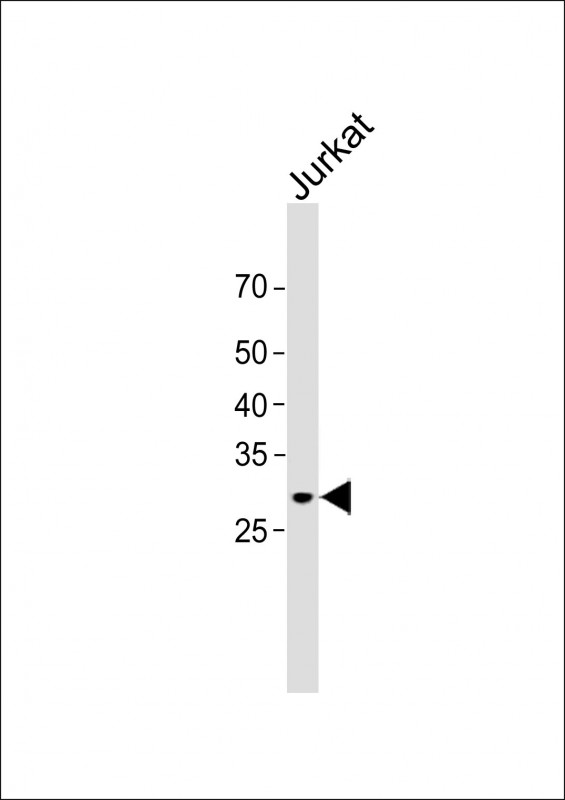CLDN18 antibody
Purified Rabbit Polyclonal Antibody (Pab)
- 产品详情
- 实验流程
- 背景知识
Application
| WB, E |
|---|---|
| Primary Accession | P56856 |
| Reactivity | Human |
| Host | Rabbit |
| Clonality | polyclonal |
| Isotype | Rabbit Ig |
| Calculated MW | 27856 Da |
| Gene ID | 51208 |
|---|---|
| Other Names | Claudin-18, CLDN18 |
| Target/Specificity | This antibody is generated from a rabbit immunized with a KLH conjugated synthetic peptide between amino acids from human. |
| Dilution | WB~~1:1000 E~~Use at an assay dependent concentration. |
| Format | Purified polyclonal antibody supplied in PBS with 0.05% (V/V) Proclin 300. This antibody is purified through a protein A column, followed by peptide affinity purification. |
| Storage | Maintain refrigerated at 2-8°C for up to 2 weeks. For long term storage store at -20°C in small aliquots to prevent freeze-thaw cycles. |
| Precautions | CLDN18 antibody is for research use only and not for use in diagnostic or therapeutic procedures. |
| Name | CLDN18 |
|---|---|
| Function | Involved in alveolar fluid homeostasis via regulation of alveolar epithelial tight junction composition and therefore ion transport and solute permeability, potentially via downstream regulation of the actin cytoskeleton organization and beta-2-adrenergic signaling (By similarity). Required for lung alveolarization and maintenance of the paracellular alveolar epithelial barrier (By similarity). Acts to maintain epithelial progenitor cell proliferation and organ size, via regulation of YAP1 localization away from the nucleus and thereby restriction of YAP1 target gene transcription (By similarity). Acts as a negative regulator of RANKL-induced osteoclast differentiation, potentially via relocation of TJP2/ZO-2 away from the nucleus, subsequently involved in bone resorption in response to calcium deficiency (By similarity). Mediates the osteoprotective effects of estrogen, potentially via acting downstream of estrogen signaling independently of RANKL signaling pathways (By similarity). |
| Cellular Location | Cell junction, tight junction {ECO:0000250|UniProtKB:P56857}. Cell membrane {ECO:0000250|UniProtKB:P56857}; Multi-pass membrane protein. Note=Localizes to tight junctions in epithelial cells {ECO:0000250|UniProtKB:P56857} [Isoform A2]: Cell junction, tight junction {ECO:0000250|UniProtKB:P56857}. Lateral cell membrane {ECO:0000250|UniProtKB:P56857} |
| Tissue Location | [Isoform A1]: Expression is restricted to the lung. |
For Research Use Only. Not For Use In Diagnostic Procedures.
Provided below are standard protocols that you may find useful for product applications.
BACKGROUND
Involved in alveolar fluid homeostasis via regulation of alveolar epithelial tight junction composition and therefore ion transport and solute permeability, potentially via downstream regulation of the actin cytoskeleton organization and beta-2-adrenergic signaling (By similarity). Required for lung alveolarization and maintenance of the paracellular alveolar epithelial barrier (By similarity). Acts to maintain epithelial progenitor cell proliferation and organ size, via regulation of YAP1 localization away from the nucleus and thereby restriction of YAP1 target gene transcription (By similarity). Acts as a negative regulator of RANKL-induced osteoclast differentiation, potentially via relocation of TJP2/ZO-2 away from the nucleus, subsequently involved in bone resorption in response to calcium deficiency (By similarity). Mediates the osteoprotective effects of estrogen, potentially via acting downstream of estrogen signaling independently of RANKL signaling pathways (By similarity).
REFERENCES
Niimi T.,et al.Mol. Cell. Biol. 21:7380-7390(2001).
Clark H.F.,et al.Genome Res. 13:2265-2270(2003).
Mural R.J.,et al.Submitted (SEP-2005) to the EMBL/GenBank/DDBJ databases.
Sahin U.,et al.Clin. Cancer Res. 14:7624-7634(2008).
LaFemina M.J.,et al.Am. J. Respir. Cell Mol. Biol. 51:550-558(2014).
终于等到您。ABCEPTA(百远生物)抗体产品。
点击下方“我要评价 ”按钮提交您的反馈信息,您的反馈和评价是我们最宝贵的财富之一,
我们将在1-3个工作日内处理您的反馈信息。
如有疑问,联系:0512-88856768 tech-china@abcepta.com.























 癌症的基本特征包括细胞增殖、血管生成、迁移、凋亡逃避机制和细胞永生等。找到癌症发生过程中这些通路的关键标记物和对应的抗体用于检测至关重要。
癌症的基本特征包括细胞增殖、血管生成、迁移、凋亡逃避机制和细胞永生等。找到癌症发生过程中这些通路的关键标记物和对应的抗体用于检测至关重要。 为您推荐一个泛素化位点预测神器——泛素化分析工具,可以为您的蛋白的泛素化位点作出预测和评分。
为您推荐一个泛素化位点预测神器——泛素化分析工具,可以为您的蛋白的泛素化位点作出预测和评分。 细胞自噬受体图形绘图工具为你的蛋白的细胞受体结合位点作出预测和评分,识别结合到自噬通路中的蛋白是非常重要的,便于让我们理解自噬在正常生理、病理过程中的作用,如发育、细胞分化、神经退化性疾病、压力条件下、感染和癌症。
细胞自噬受体图形绘图工具为你的蛋白的细胞受体结合位点作出预测和评分,识别结合到自噬通路中的蛋白是非常重要的,便于让我们理解自噬在正常生理、病理过程中的作用,如发育、细胞分化、神经退化性疾病、压力条件下、感染和癌症。






